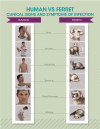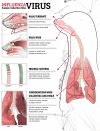Complexities in Ferret Influenza Virus Pathogenesis and Transmission Models
- PMID: 27412880
- PMCID: PMC4981671
- DOI: 10.1128/MMBR.00022-16
Complexities in Ferret Influenza Virus Pathogenesis and Transmission Models
Abstract
Ferrets are widely employed to study the pathogenicity, transmissibility, and tropism of influenza viruses. However, inherent variations in inoculation methods, sampling schemes, and experimental designs are often overlooked when contextualizing or aggregating data between laboratories, leading to potential confusion or misinterpretation of results. Here, we provide a comprehensive overview of parameters to consider when planning an experiment using ferrets, collecting data from the experiment, and placing results in context with previously performed studies. This review offers information that is of particular importance for researchers in the field who rely on ferret data but do not perform the experiments themselves. Furthermore, this review highlights the breadth of experimental designs and techniques currently available to study influenza viruses in this model, underscoring the wide heterogeneity of protocols currently used for ferret studies while demonstrating the wealth of information which can benefit risk assessments of emerging influenza viruses.
Copyright © 2016, American Society for Microbiology. All Rights Reserved.
Figures




References
-
- Maines TR, Lu XH, Erb SM, Edwards L, Guarner J, Greer PW, Nguyen DC, Szretter KJ, Chen LM, Thawatsupha P, Chittaganpitch M, Waicharoen S, Nguyen DT, Nguyen T, Nguyen HH, Kim JH, Hoang LT, Kang C, Phuong LS, Lim W, Zaki S, Donis RO, Cox NJ, Katz JM, Tumpey TM. 2005. Avian influenza (H5N1) viruses isolated from humans in Asia in 2004 exhibit increased virulence in mammals. J Virol 79:11788–11800. doi:10.1128/JVI.79.18.11788-11800.2005. - DOI - PMC - PubMed
Publication types
MeSH terms
LinkOut - more resources
Full Text Sources
Other Literature Sources

